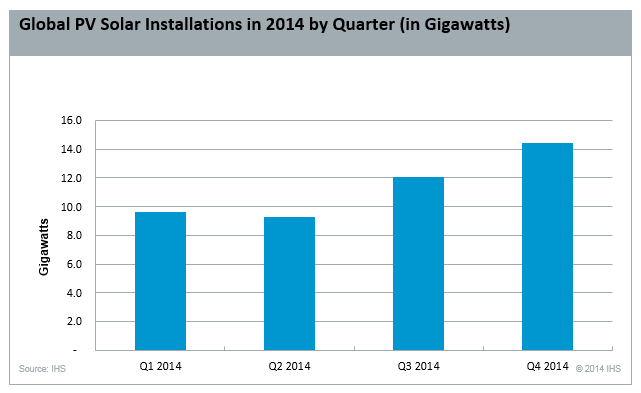World Solar Power 2014: Countries Installing Equivalent Of 12 Nuclear Power Plants Worth Of Solar Capacity

Global solar panel installations are expected to hit 45.4 gigawatts of capacity for 2014, fueled largely by robust development in China, the United States and the U.K., IHS Technology said Wednesday. Put into perspective, America’s largest nuclear power plant near Phoenix, Arizona, has a capacity of 3.7 gigawatts and provides power to 4 million people in the Southwest and Southern California.

The numbers illustrate the steady rise of solar and other forms of renewable energy as nuclear power’s share of energy output continues to decline in the aftermath of the 2011 Fukushima Daiichi nuclear disaster in Japan.
“With China installing more than 5 GW and the United States installing 2.3 GW in the fourth quarter of 2014, these two countries will account for more than 50 percent of global installations during this period,” Ash Sharma, senior director of solar research at IHS, said in an email.
After a sluggish start to the year, thanks in part to a slowdown in solar installations in Germany and Italy, fourth-quarter global photovoltaic (PV) solar installations will hit 14.4 GW, or about 32 percent of the total for 2014. The U.K. made significant advances this year to become the world’s fourth-largest solar power producer, after China, Japan and the United States. The country is expected to complete about 3.1 GW of solar power capacity by the end of the year.
IHS says it expected global PV installations to slow from over 20 percent annual growth in 2013 and 2014 to 16 percent next year, or 53 GW. The International Energy Agency (IEA) estimates the total global solar power capacity will grow from 98 GW in 2012 to 308 GW in 2018. In 2000, the global solar capacity was just 1.5 GW, according to the IEA.

Meanwhile, nuclear power capacity has declined as countries grow increasingly wary of the current risks and expenses in maintaining modern, safe plants. The Fukushima nuclear disaster spurred Germany to announce it would phase out nuclear sources of energy, opting instead to aggressively expand into wind and solar.
“Nuclear energy’s share of global power production has declined steadily from a peak of 17.6 percent in 1996 to 10.8 percent in 2013,” said a report released in September by the Worldwatch Institute, a green energy advocacy group. “Renewables increased their share from 18.7 percent in 2000 to 22.7 percent in 2012.”
© Copyright IBTimes 2024. All rights reserved.





















